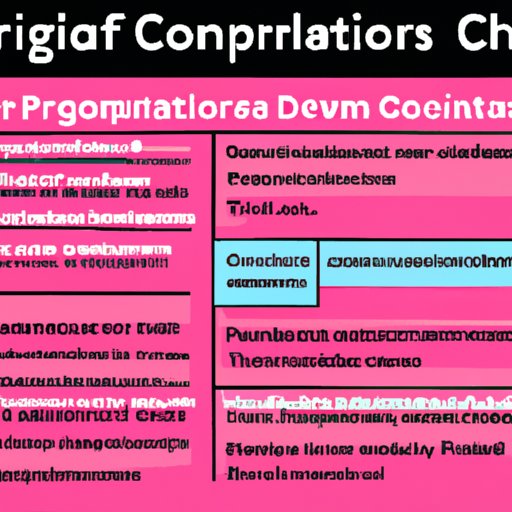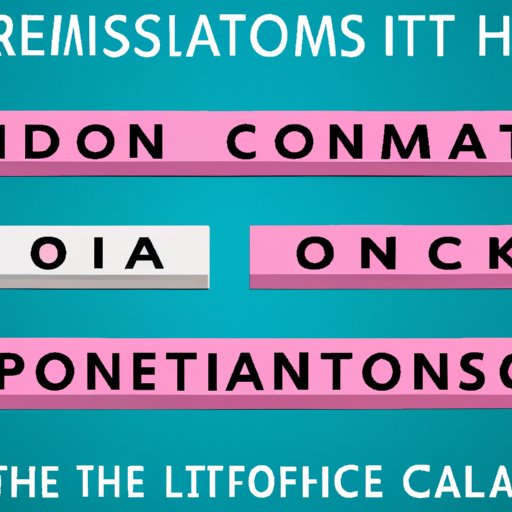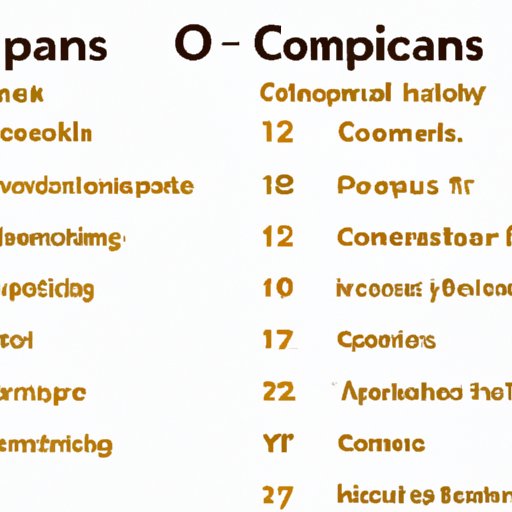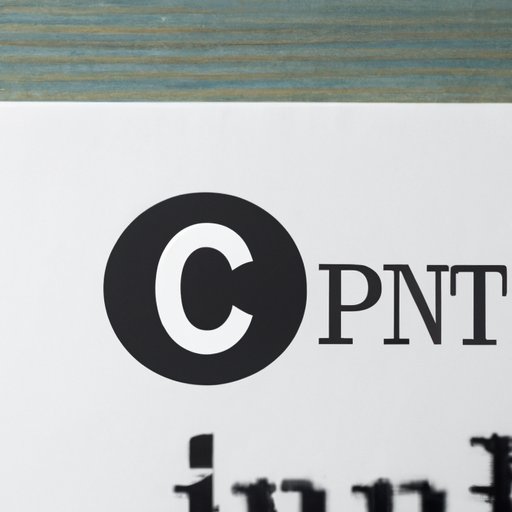Introduction
Creative Commons licenses are a type of copyright license that allows creators to share their work with others while still maintaining some control over it. They provide an alternative to traditional copyright law, allowing creators to grant certain permissions to users for free. In this article, we will explore the different types of Creative Commons licenses, their advantages and disadvantages, and how to choose the right license for your work.

Exploring the Different Types of Creative Commons Licenses: A Comprehensive Guide
Creative Commons licenses are divided into six main categories: Attribution (CC BY), Attribution-ShareAlike (CC BY-SA), Attribution-NoDerivs (CC BY-ND), Attribution-NonCommercial (CC BY-NC), Attribution-NonCommercial-ShareAlike (CC BY-NC-SA), and Attribution-NonCommercial-NoDerivs (CC BY-NC-ND). Let’s take a closer look at each one.
Attribution (CC BY)
The Attribution (CC BY) license is the most basic Creative Commons license. It allows others to distribute, remix, tweak, and build upon your work, even commercially, as long as they credit you for the original creation. This is the most open of all Creative Commons licenses.
Attribution-ShareAlike (CC BY-SA)
The Attribution-ShareAlike (CC BY-SA) license is similar to the Attribution (CC BY) license, but it also requires that any derivative works be licensed under the same terms. This ensures that any changes made to your work are shared with the same freedoms as the original.
Attribution-NoDerivs (CC BY-ND)
The Attribution-NoDerivs (CC BY-ND) license allows others to distribute your work, but not to make any changes or adaptations to it. This license is best suited for works that don’t require any modification.
Attribution-NonCommercial (CC BY-NC)
The Attribution-NonCommercial (CC BY-NC) license allows others to remix, tweak, and build upon your work non-commercially, and they must credit you for the original creation. This license is best suited for creators who don’t want their work used for commercial purposes.
Attribution-NonCommercial-ShareAlike (CC BY-NC-SA)
The Attribution-NonCommercial-ShareAlike (CC BY-NC-SA) license is similar to the Attribution-NonCommercial (CC BY-NC) license, but it also requires that any derivative works be licensed under the same terms. This ensures that any changes made to your work are shared with the same freedoms as the original.
Attribution-NonCommercial-NoDerivs (CC BY-NC-ND)
The Attribution-NonCommercial-NoDerivs (CC BY-NC-ND) license is the most restrictive of all Creative Commons licenses. It allows others to download and share your work, but they can’t change it in any way or use it commercially.
The Pros and Cons of Utilizing Creative Commons Licenses
Creative Commons licenses offer many benefits, but there are also some drawbacks to consider. Here are some of the pros and cons of using Creative Commons licenses.
Advantages
One of the biggest advantages of using Creative Commons licenses is that they make it easy for creators to share their work with others while still maintaining some control over it. Additionally, Creative Commons licenses are free and simple to use. This makes them accessible to people who may not have the resources or knowledge to navigate traditional copyright laws.
Furthermore, Creative Commons licenses can help creators build a reputation for their work and increase their visibility online. By licensing their work under Creative Commons, creators can ensure that their work is seen by more people and can be used in more contexts.
Disadvantages
One of the drawbacks of using Creative Commons licenses is that they do not provide the same level of protection as traditional copyright law. Creative Commons licenses are not legally enforceable, which means that if someone violates the terms of the license, the creator has no legal recourse. Additionally, the terms of Creative Commons licenses are not always clear, so it’s important to read the fine print before using one.
Additionally, Creative Commons licenses only apply to copyrightable works. This means that works that are not subject to copyright, such as facts and ideas, cannot be protected by Creative Commons licenses.

How to Choose the Right Creative Commons License for Your Work
Choosing the right Creative Commons license for your work can be tricky. Here are some tips for selecting the right license.
Assessing Your Needs
Before choosing a Creative Commons license, it’s important to consider what you want to accomplish with it. Do you want to allow others to use and modify your work, or do you want to limit the uses of your work? Are you comfortable with others making money off of your work, or do you want to restrict commercial use? Answering these questions can help you determine which license is best for your needs.
Understanding the Different Licenses
Once you’ve determined what you want to accomplish with your license, it’s time to start exploring the different types of Creative Commons licenses. Take some time to read through the different licenses and familiarize yourself with the terms and conditions of each one. This will ensure that you choose the right license for your work.

A Comparison of the Most Popular Creative Commons Licenses
Here is a quick overview of the most popular Creative Commons licenses and what they allow.
CC BY
The Attribution (CC BY) license allows others to distribute, remix, tweak, and build upon your work, even commercially, as long as they credit you for the original creation.
CC BY-SA
The Attribution-ShareAlike (CC BY-SA) license is similar to the Attribution (CC BY) license, but it also requires that any derivative works be licensed under the same terms.
CC BY-NC
The Attribution-NonCommercial (CC BY-NC) license allows others to remix, tweak, and build upon your work non-commercially, and they must credit you for the original creation.
CC BY-NC-SA
The Attribution-NonCommercial-ShareAlike (CC BY-NC-SA) license is similar to the Attribution-NonCommercial (CC BY-NC) license, but it also requires that any derivative works be licensed under the same terms.
CC BY-NC-ND
The Attribution-NonCommercial-NoDerivs (CC BY-NC-ND) license is the most restrictive of all Creative Commons licenses. It allows others to download and share your work, but they can’t change it in any way or use it commercially.
Understanding Copyright Law and Creative Commons Licenses
It’s important to understand the difference between copyright law and Creative Commons licenses. While Creative Commons licenses are a form of copyright protection, they are not a substitute for traditional copyright law. Copyright law provides much more comprehensive protection than Creative Commons licenses, but it can be difficult to navigate and costly to enforce.
What is Copyright Law?
Copyright law is a set of laws that protect the rights of creators by giving them exclusive rights to their work. These rights include the right to reproduce, distribute, display, perform, and modify the work. Copyright protection lasts for the life of the author plus 70 years.
What Are the Limitations of Creative Commons Licenses?
Creative Commons licenses are limited in scope and are not legally enforceable. Additionally, they cannot be used to protect works that are not subject to copyright, such as facts and ideas. Finally, Creative Commons licenses do not provide the same level of protection as traditional copyright law.
Conclusion
Creative Commons licenses are a great way for creators to share their work with others while still maintaining some control over it. They are free and simple to use, and they can help creators build a reputation for their work and increase their visibility online. However, it’s important to understand the limitations of Creative Commons licenses and how they differ from traditional copyright law.
Summary of Creative Commons Licenses
Creative Commons licenses are divided into six main categories: Attribution (CC BY), Attribution-ShareAlike (CC BY-SA), Attribution-NoDerivs (CC BY-ND), Attribution-NonCommercial (CC BY-NC), Attribution-NonCommercial-ShareAlike (CC BY-NC-SA), and Attribution-NonCommercial-NoDerivs (CC BY-NC-ND). Each license has its own set of rules and restrictions, so it’s important to read the fine print before using one.
Final Thoughts on Choosing the Right License for Your Work
When choosing a Creative Commons license for your work, it’s important to assess your needs and understand the different licenses available. Additionally, it’s important to understand the limitations of Creative Commons licenses and how they differ from traditional copyright law. By following these guidelines, you can ensure that you choose the right license for your work.
(Note: Is this article not meeting your expectations? Do you have knowledge or insights to share? Unlock new opportunities and expand your reach by joining our authors team. Click Registration to join us and share your expertise with our readers.)
